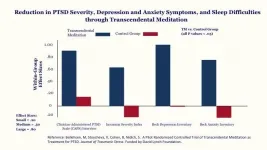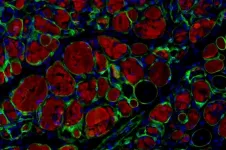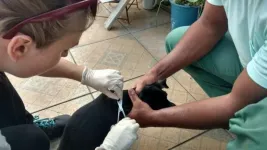"Our goal in this study was to treat patients on the mobile stroke unit within an hour of the onset of their stroke symptoms, and we were gratified that one-third of the patients were actually treated within that time frame," said James C. Grotta, M.D., lead study author and director of stroke research at the Clinical Institute for Research and Innovation at Memorial Hermann - Texas Medical Center in Houston. "Our study confirmed that patients who are treated early benefit from a complete reversal of stroke symptoms and avoidance of disability. This suggests that in the first hour after a stroke occurs, the brain is not yet irreversibly damaged and is very amenable to effective treatment."
Mobile stroke units are special ambulances equipped to diagnose and treat stroke quickly. When a stroke is caused by a blood clot blocking an artery in or leading to the brain (an ischemic stroke), the team on board the mobile stroke unit can treat the patient right away with a clot-dissolving medication called tissue plasminogen activator (tPA).
This research, which is part of the ongoing, national BEST-MSU study, examined data from 1,047 patients who suffered an ischemic stroke and were eligible for tPA treated at seven U.S. centers (Houston; Aurora, Colorado; New York City; Indianapolis; Los Angeles; Memphis, Tennessee; and Burlingame, California) between 2014 and 2020. Researchers compared outcomes of stroke patients brought to the emergency department by mobile stroke unit versus those who arrived by standard emergency medical services (617 patients via mobile stroke unit, and 430 patients via standard ambulance).
They found:
Overall, 97% of patients transported by a mobile stroke unit received tPA, compared to 80% of those brought to the emergency department by a regular ambulance. One-third of the patients treated by a mobile stroke unit were treated within one hour after the onset of stroke symptoms, compared to only 3% of patients transported by a standard ambulance. 53% of the patients treated by a mobile stroke unit made a complete recovery from the stroke after three months while 43% of the patients treated by a standard ambulance achieved a full recovery. "Our results mean that, on average, for every 100 patients treated on a mobile stroke unit rather than standard ambulance, 27 will have less final disability and 11 of the 27 will be disability-free," Grotta said. "But for this to happen, patients, caregivers and bystanders need to recognize the signs of stroke and call 9-1-1 immediately."
"More widespread deployment of mobile stroke units may have a major public health impact on reducing disability from stroke," said Grotta. "Although mobile stroke units are costly to equip and staff, they reduce the time to treatment. We also expect that more treatment via mobile stroke units can reduce the need for downstream utilization of long-term care."
More research is ongoing by Grotta and his team to assess health care utilization over the entire year following their patients' strokes which will enable a better idea of the cost effectiveness of mobile stroke unit implementation on a wider scale. The American Heart Association's 2019 Recommendations for the Establishment of Stroke Systems of Care suggests reimbursement is an issue that warrants further investigation before widespread use of mobile stroke units is likely.
INFORMATION:
According to the American Heart Association's Heart Disease and Stroke Statistics -- 2021 Update, when considered separately from other CVD, stroke ranks No. 5 among all causes of death in the U.S., causing 147,810 deaths in 2018. Stroke occurs when a blood vessel to or in the brain either becomes blocked or bursts, preventing blood and oxygen from reaching all of the brain. Treatment to quickly restore blood flow to the brain is essential to improve outcomes and survival.
To recognize stroke symptoms requiring immediate treatment, the American Stroke Association recommends everyone remember the acronym F.A.S.T. for face drooping, arm weakness, speech difficulty, time to call 9-1-1. Fortunately, most strokes are preventable through healthy lifestyle choices: not smoking; eating healthy foods; being physically active; maintaining a healthy body weight; and controlling high blood sugar, cholesterol and blood pressure.
Study co-authors are Stephanie Parker, MHA, B.S.N., R.N.; Ritvij Bowry, M.D.; Nicole R. Gonzales, M.D.; William Jones, M.D.; Anne W. Alexandrov, Ph.D., R.N., C.C.R.N.; Babak Navi, M.D., M.S.; May Nour, M.D., Ph.D.; Ilana Spokoyny, M.D.; Jason Mackey, M.D.; Asha Jacob, MPH, M.D.; Patti Bratina, B.S.N, R.N.; Nicole Rangel-Gutierrez, ACNP; Brandi Schimpf, B.S.N., R.N.; Michael Eisshofer, B.S.N.; Janice Miller, M.D.; Andrei V. Alexandrov, M.D.; James Rhudy, Ph.D.; Matthew E. Fink, M.D.; Joshua Z. Willey, M.D., M.S.; Carla Sherman, R.N., B.S.N.; Jeffrey L. Saver, M.D.; Kevin Brown, ARRT, CT; Bryan Villareal, R.N., B.S.N.; Joey English, M.D., Ph.D.; Nobl Barazangi, M.D., Ph.D.; Sarah Collins, R.N.; Kelly Silnes, M.S.; Vivek Misra, M.D.; Mengxi Wang, Ph.D.; Noopur Singh, M.P.H.; Suja S. Rajan, Ph.D.; and Jose-Miguel Yamal, Ph.D. The list of author disclosures is available in the abstract.
The study was supported by the Patient Centered Outcomes Research Institute, the American Heart Association and Genentech.
Additional Resources:
Multimedia is available on the right column of release link: https://newsroom.heart.org/news/mobile-stroke-units-improve-outcomes-and-reduce-disability-among-stroke-patients?preview=b075a5dde99d452e94e7ead4cfc6b037
What is Brain Health?
Fast treatment via mobile stroke unit reduced survivor disability
Mobile stroke units could expedite treatment and improve patient outcomes in urban areas
American Stroke Association policy statement on stroke systems of care
For more news at ASA International Stroke Conference 2021, follow us on Twitter @HeartNews #ISC21.
Statements and conclusions of studies that are presented at the American Heart Association's scientific meetings are solely those of the study authors and do not necessarily reflect the Association's policy or position. The Association makes no representation or guarantee as to their accuracy or reliability. The Association receives funding primarily from individuals; foundations and corporations (including pharmaceutical, device manufacturers and other companies) also make donations and fund specific Association programs and events. The Association has strict policies to prevent these relationships from influencing the science content. Revenues from pharmaceutical and biotech companies, device manufacturers and health insurance providers are available here, and the Association's overall financial information is available here.
The American Stroke Association's International Stroke Conference (ISC) is the world's premier meeting dedicated to the science and treatment of cerebrovascular disease. ISC 2021 is virtual, March 17-19, 2021. This 3-day conference will feature more than 1,200 compelling presentations in 21 categories that emphasize basic, clinical and translational sciences as they evolve toward a better understanding of stroke pathophysiology with the goal of developing more effective therapies. Engage in the International Stroke Conference on social media via #ISC21.
About the American Stroke Association
The American Stroke Association is devoted to saving people from stroke -- the No. 2 cause of death in the world and a leading cause of serious disability. We team with millions of volunteers to fund innovative research, fight for stronger public health policies and provide lifesaving tools and information to prevent and treat stroke. The Dallas-based association officially launched in 1998 as a division of the American Heart Association. To learn more or to get involved, call 1-888-4STROKE or visit stroke.org. Follow us on Facebook, Twitter.




